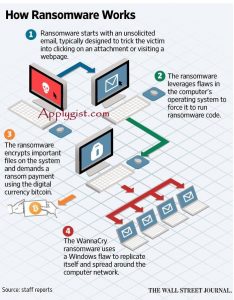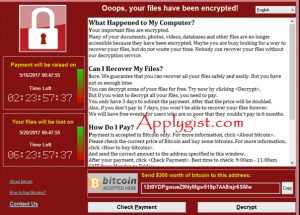Technology – Deadly Computer Virus called WannaCry is a ransomware
WannaCry is a ransomware computer worm that targets computers running the Microsoft Windows operating system especial Operating systems running on Windows XP. 200,000 computers
Google Chrome Passwords- Best way to recover any usernames and passwords READ MOE

Deadly Computer Virus called WannaCry
According to Wikipedia this virus works like modern ransomware; it finds and encrypts a range of data files, then displays a “ransom note” informing the user and demanding a payment in bitcoin. It is considered a network worm because it also includes a “transport” mechanism to automatically spread itself. This transport code scans for vulnerable systems, then uses the EternalBlue exploit to gain access, and the DoublePulsar exploit to install and execute a copy of itself.
According to research conducted, on 12 May 2017, WannaCry began affecting computers worldwide with evidence pointing to an initial infection in Asia at 7:44am UTC.
When executed, the malware first checks the “kill switch” domain name, if it is not found, then the ransomware encrypts the computer’s data, then attempts to exploit the SMB vulnerability to spread out to random computers on the Internet. 200,000 computers This is “laterally” done to computers on the same network. As with other modern ransomware, the payload displays a message informing the user that files have been encrypted, and demands a payment of around $300 in bitcoin within three days or $600 within seven days
Deadly Computer Virus called WannaCry
What are its Impact?
Research has revealed that that around 200,000 computers were infected across 150 countries. According to Kaspersky Lab, the four most affected countries were Russia, Ukraine, India and Taiwan. 200,000 computers
In Addition, he attack affected many National Health Service hospitals in England and Scotland and up to 70,000 devices

If you aren’t receiving your password-assistance email, please follow the steps below:
Check your inbox for an email with the subject line “Google Verification Code.” – If you don’t use Gmail, check the inbox of the email address you use to sign in to your account. If you use Gmail, check the inbox of the recovery email address you provided when you signed up for Gmail. If you didn’t provide a recovery email address, wait 24 hours and answer your security question.
Check your Spam or Bulk Mail folders.- It’s possible that the email we tried to send you was caught by a spam or bulk mail filter in your email system. Look for an email from Google with the subject line “Google Verification Code.” If you don’t find the email in these folders, add noreply@google.com to your address book, and request another password-assistance email
Discover more from Applygist Tech News
Subscribe to get the latest posts sent to your email.

Hi, Dear Administrator! You can earning much more money from all of your sites via our new Super Easy To Use WP plugin by IM INCOME LAB (Mark Hess & Micheal Thomas). Demo and Download page